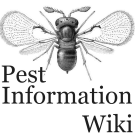Publications for:
pest = Tetranychus urticae
crop = Beans (Phaseolus)
country = Japan
found 7 publications:2004
Effects of exogenous Jasmonic acid and benzo (1,2,3) thiadiazole-7-carbothioic acid S-methyl ester (BTH), a functional analogue of salicylic acid, on the egg production of a herbivorous mite Tetranychus urticae (Acari: Tetranychidae)Applied Entomology and Zoology (2004) 39 (2), 311-314
publishers website - pestinfo wiki
Does Tetranychus urticae (Acari: Tetranychidae) use flying insects as vectors for phoretic dispersal?
Experimental and Applied Acarology (2004) 32 (4), 243-248
publishers website - pestinfo wiki
2003
A comparison of the responses of Tetranychus urticae (Acari: Tetranychidae) and Phytoseiulus persimilis (Acari: Phytoseiidae) to volatiles emitted from lima bean leaves with different levels of damage made by T urticae or Spodoptera exigua (Lepidoptera: Noctuidae)Applied Entomology and Zoology (2003) 38 (1), 109-116
publishers website - pestinfo wiki
2001
Response of Oligota kashmirica benefica, a specialist insect predator of spider mites, to volatiles from prey-infested leaves under both laboratory and field conditionsEntomologia Experimentalis et Applicata (2001) 101 (1), 41-47
publishers website - pestinfo wiki
Variation in the olfactory response of 13 populations of the predatory mite Amblyseius womersleyi (Acari: Phytoseiidae, Tetranychidae) to Tetranychus urticae -infested plant volatiles (Acari: Phytoseiidae, Tetranychidae)
Experimental and Applied Acarology (2001) 25 (1), 55-64
publishers website - pestinfo wiki
2000
The effects of rearing conditions on the olfactory response of predatory mites, Phytoseiulus persimilis and Amblyseius womersleyi (Acari : Phytoseiidae)Applied Entomology and Zoology (2000) 35 (3), 345-351
publishers website - pestinfo wiki
1999
Response of the predatory mite, Amblyseius womersleyi (Acari : Phytoseiidae), toward herbivore-induced plant volatiles: Variation in response between two local populationsApplied Entomology and Zoology (1999) 34 (4), 449-454
pestinfo wiki
